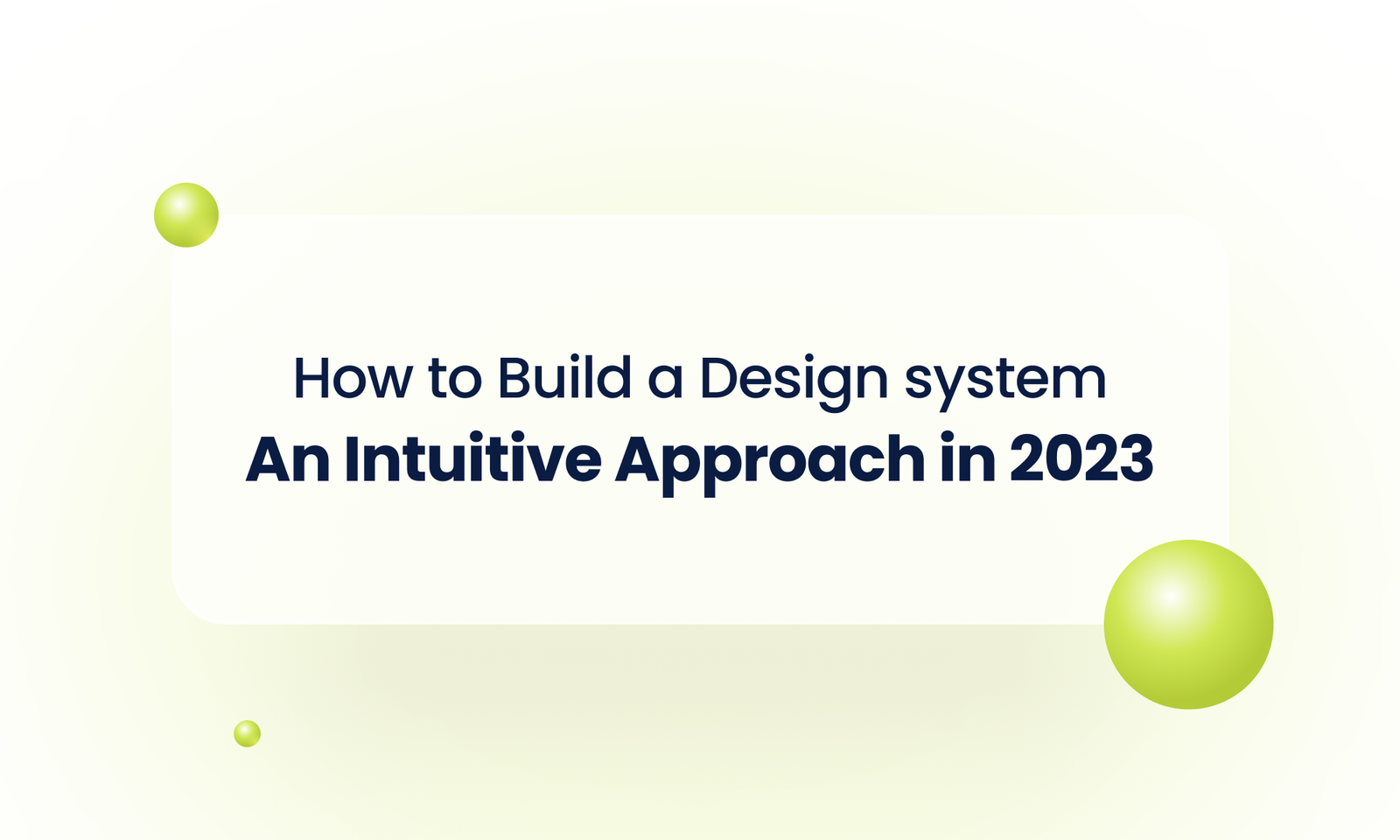A design system is one which helps in making a successful digital product. It is a complete set of rules that help in organizing things. This guide will tell you step-by-step how to build a design system from scratch. It contains important information that is usually not publicly available.
There are some design system guidelines that must be followed in order to come up with a successful product. We have covered a great deal of information that talks about all the alternatives that one must take for a smooth process.
What is a design System?

A design system is a set of reusable components that have the highest possibility of being repeated throughout the design process. That means a design system is one that facilitates the creation of digital products in a systematic way.
There are certain guidelines on how to use the design system and they must be strictly followed to design the best systems. The systems that go in accordance with what is actually required.
The design system process can be difficult as you may have to go through many complexities before completion. You may have to face uncountable hurdles along the way which is a great way to learn. Oftentimes, design systems are of so much value that they become an identity for your company. Then you can use this identity for design system guidelines, or for your own set of rules and standards.
Types of Design System
There are no specific types of design systems as companies design them for their own custom use. However, there are some examples of great UI designs which you can take inspiration from:

Material design is a language developed by Google for Android systems. It strictly follows the design system guidelines and assists the users in the usage of the device. Since Google has strong standards, it has kept its material design unique that can be followed across all Android devices.
Google has shown that usage gets really easy if the same design system principles are used throughout. This increases familiarity which helps users in understanding the interface even if they switch to a different device. In other words, it makes navigation between the devices easier. That is why it is so popular among Android Users.

Like Google Material Design is for Android, AHIG ( Apple Human Interface Guidelines) is for Apple devices. With the help of AHIG, designers can easily form a set of rules that brings uniformity across all Apple devices. No other rules can be of any use as Apple has pretty set standards and it doesn’t like to deviate from its path.
AHIG’s toughness gives out a message on how to build a design system that goes perfectly with what users want. Apple has demonstrated a great example of how to take care of usability while staying in a specified design language.

IBM also has its own set of principles that they use to define its own unique model. With Carbon Design, it is possible for IBM to maintain a design discipline in all their products. Designers are able to craft a system that can fully comply with rules and also goes in handy with users.
The Carbon Design systems can fully take care of users’ needs and also contains the information for designers. It contains code guidelines and also on how to build a design system whose success lasts long. IBM has its own image in the world, What’s your favorite IBM product?

Similarly, Atlassian products follow their own set of rules in order to provide the best user experience. There are separate guidelines for designers and developers, and together they deliver above expectations.
Atlassian products show consistency in the design systems, and it’s all because of standard rules. One good example of how to build a design system lies in consistent designs. Atlassian Design Systems are constantly showing progress towards perfectionism. There’s a big reason why Atlassian products are gaining so much popularity. It is just ease of use and engaging user experience.
Review Current Design Assets and Processes

Constant design reviews are a routine part of the product development lifecycle to ensure top quality. To review design assets, first, you need to know whether the designs are in conformity with the niche or not.
When designs are not related then surely you need to re-strategize and have some insights on how to build a design system. Building a Design system requires lots of effort as you need to apply knowledge in all areas.
Here are some areas to look at to revitalize your design system;
- Consistency
- Accessibility
- Collaboration
- Scalability
If you are looking for a good design system then you may contact us for a final review or maybe have it built from scratch.
Set Up Design Principles And Guidelines

The biggest challenge designers often face is the creation of appropriate principles and guidelines. What happens most of the time is that designers do follow the guidelines but somehow deviate from the path at some point.
To prevent the wasted efforts of designers, either guideline should be more clear or designers shouldn’t be making any mistakes at all. But, making mistakes is a part of nature and one must try to reduce it with constant practice.
Guidelines are there to reduce the mistakes that are constantly performed.
Some examples of Design Principles:
- Consistency Principle
- Simplicity Principle
- Hierarchy Principle
- Grids and Spacing Principle
Some examples of Design Guidelines:
- Accessibility Guidelines
- Branding Guidelines
- Content Guidelines
Create A Component Library

Creating a component library can be a challenge as you have to manage all the components for reusability in a repository. Sometimes it also results in data loss and recovering that data is the most cumbersome task.
Most of the job is done when the design system is defined and the components are put in order. The job of the component library is to maintain consistency across the projects and working on solutions becomes easy.
The components such as buttons, forms, and navigational bars are the most basic ones, and the library isn’t complete without them. All you got to do is equip your library with a large number of components so you can keep using them in a maximum number of projects.
Popular examples of a component library are:
- Bootstrap
- Material UI
- Ant Design
- Semantic UI
- Foundation
Build A Visual Design Language

Devising a visual design language toolkit or strategy can be a tiresome work if you don’t have any prior experience, but after reading this topic you’ll be able to easily gather design elements that would be tailored to your brand theme and goals.
So what are those design elements? Here are the following design elements that you can use in your design projects.
- Color Palettes
- Typography
- Icons
- Images
- Layout and Grids
Language creation will give you a clear understanding of how to build a design system and how to initialize it. Language is a way of communication and it is done to explain concepts, so it has a similar role here. Visual design language helps in understanding complex concepts which greatly helps to avoid inconsistencies.
Add Design System Documentation

Documentation is a backbone of a project containing a clear set of guidelines for developers and designers to understand. It has all the information on how to build a design system step by step in a clear manner. The use of documentation also helps in removing confusion and making up a solid strategy.
Understanding every bit of the design process is an intricate matter, which is why the usage of documentation is important. It widens your perspective and you start seeing hidden things. Slowly it becomes a habit of developers to consider even the smallest of guidelines. This ensures that developers are attention-focused and don’t miss even the slightest detail.
Documentation also helps with accessibility and making new design patterns as that is what is used for boosting software quality. There are other factors such as the development and maintenance of the software that has to be done on regular basis. Good documentation completes your project in an actual sense.
Launch And Maintain The Design System
After going through a long process, finally, it’s time to launch your design structure. But, the launching process isn’t a piece of cake as it also comes with limitations. Some limitations include ‘Resistance to change’ and ‘lack of adoption’. Let’s get to discuss them.
Resistance To Change
The stakeholders might not be comfortable with using the new system as they are too accustomed to old ways. This can be dangerous as it can increase the chances of failure, despite all the hard work put into the development.
People who have less idea of how to build a design system are often unaware of what it takes to build one. So they start resisting the use of new technology out of fear of the business being slowed down.
Lack of Adoption
Lack of adopting the system is another issue as designers and developers hesitate to adopt this new system. This will result in making the system less popular. Therefore, measures should be taken to let the users know about the effectiveness of the design.
This can be done in the following ways:
- Try to get positive reviews from the clients and publish them.
- Promote by means of social media and digital advertising.
- Bring frequent updates to meet present-day requirements.
The use of these little tactics can tell you how to build a design system and maintain it for a long time. As that is how systems remain in the game in the long run.
Teach Your Designing Team
This may seem the least important part, but it is among the fundamentals of learning how to build a design system. Teaching your team how to create a design is an essential thing if you really want your system to be successful.
The first thing you should do is try to fill the knowledge gap by assessing them on different levels. The assessment results will clarify how much training they need, or even if they need any.
Providing them equal opportunities to learn also counts by giving them access to certain online resources to boost their skills. You may let them copy the design strategy as you do for the best results. This way you can also establish a culture of continuous learning in which your team can prosper without any limits.
Final Takeaway
There might be countless other ways present how to build a design system that can fulfill your requirements. But this guide was meant to target the most trusted and proven methods that have the highest probability of benefiting you.
You can choose to adopt whatever methodology you like, but very few are results-oriented. Ofcourse you can never know about all of them, but you can at least apply what you already know. Just like the things you learned from this guide, you are very much on the go to apply them.
Beware that circumstances are different for everyone, and you may need to try a different design process. Remember, you need to constantly improve your knowledge to stay updated with current trends or take help with any design expert that can audit your design system.





